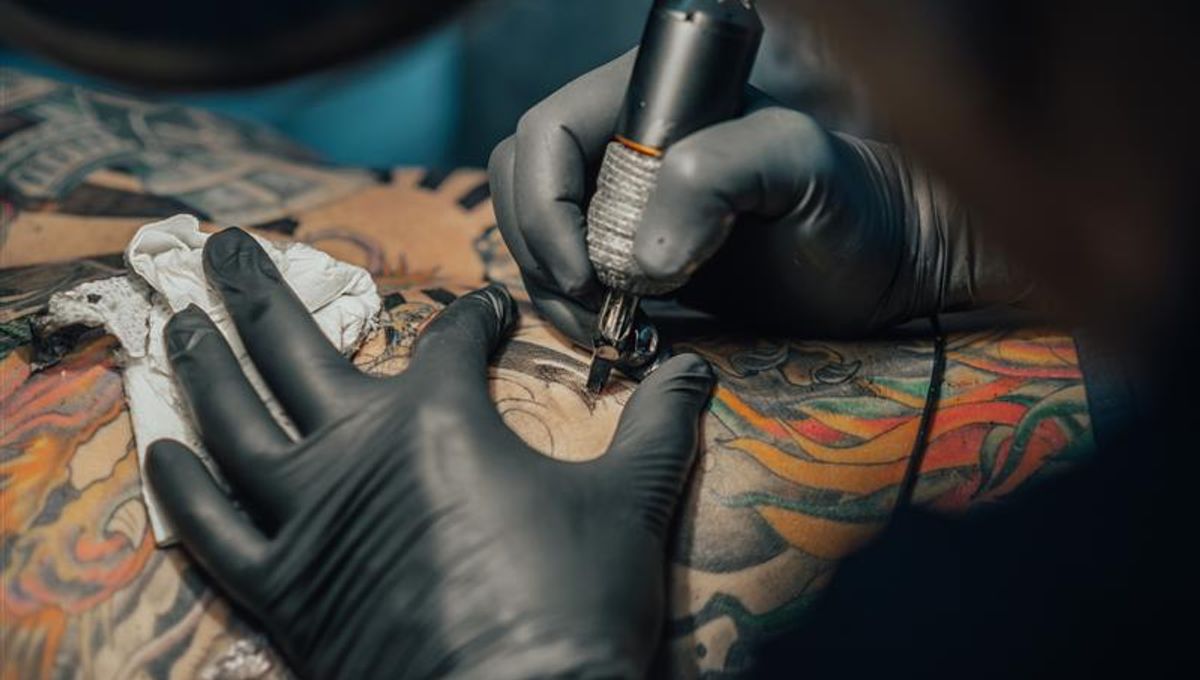
New research has analyzed tattoo inks from major and small American manufacturers and has found that 90 percent contained ingredients that were not listed on the label. In some cases, the unlisted ingredients are known to be harmful to humans.
Tattooing is an established industry these days, and it’s big business. Around the world, societal attitudes towards this type of art have shifted, which has been accompanied by a steep rise in the number of people getting them. For instance, in 2023, it was estimated that around 32 percent of US adults have at least one tattoo, while around 23 percent have more than one.
Given the popularity of this form of body modification, you would think the contents of tattoo ink were well-known and, above all else, safe for use. However, new research suggests otherwise.
Researchers at Binghamton University, in a lab run by John Swierk, Assistant Professor of Chemistry, were exploring the potential impact light can have on tattoos and their chemical breakdown. During their initial work, Kelli Moseman, a doctoral student and the new paper’s lead author, noticed that tattoo inks contained substances that were not on the labels.
This raised an important question: were these unlisted substances breakdown products from the interaction of light or were they always there?
From there, Moseman and her colleagues analyzed tattoo inks from 9 manufacturers in the US – both major, global companies as well as smaller producers. The inks analyzed came in six colors.
Of the 54 inks they examined, 45 (90 percent) had major discrepancies between their labels and their actual content, including different pigments than the ones listed or even unlisted additives.
Significantly, more than half of the inks contained polyethylene glycol, a chemical that is used to treat constipation, but can cause organ damage through repeated exposure. 15 percent contained propylene glycol, which the authors say is a potential allergen (though the US FDA does deem it as “generally recognized as safe” within limits).
Other in unlisted contents included Hexamethylenetetramine, an antibiotic often used to treat urinary infections, and 2-phenoxyethanol, an antimicrobial agent that can pose risks to nursing infants.
Despite these ingredients not being on the product’s labels, it is not currently clear whether they were included intentionally or if the manufacturers were given the wrong labels. It is also possible that these extra ingredients could be due to the ink being contaminated.
“We’re hoping the manufacturers take this as an opportunity to reevaluate their processes, and that artists and clients take this as an opportunity to push for better labeling and manufacturing,” Swierk explained in a statement.
In the US, the control of tattoo inks is significantly less strict than the European Chemicals Agency (ECHA), which regulates the European market. This is partially because until 2022, the former listed tattoo inks as “cosmetics” which were not regulated. That year, Congress passed the Modernization of Cosmetics Regulation Act (MoCRA), which allowed the FDA to regulate tattoo inks for the first time.
“The FDA is still figuring out what that is going to look like and we think this study will influence the discussions around MoCRA,” Swierk said.
“This is also the first study to explicitly look at inks sold in the United States and is probably the most comprehensive because it looks at the pigments, which nominally stay in the skin, and the carrier package, which is what the pigment is suspended in.”
The study only focused on substances at 2,000 parts per million (ppm) or more, which is considered high. However, in Europe, substances in the 2 ppm range are also considered, which means there could be more substances in the inks that were not detected by the lab.
The next step, Moseman explained, is to assess pigments banned in Europe to see if these same components are found in them. She is currently examining blue and green inks sold in Europe, which have particularly been targeted by the European regulators.
“Our goal in a lot of this research is to empower artists and their clients. Tattoo artists are serious professionals who have dedicated their lives to this craft and they want the best possible outcomes for their clients,” Swierk said. “We’re trying to highlight that there are some deficiencies in manufacturing and labeling.”
What is vegan tattoo ink?
Despite Moseman and colleague’s concerning findings, people are increasingly cautious about the types of substances they put in their bodies. In particular, vegans have become worried that tattoo inks contain substances derived from animal parts.
Although there are high-quality inks that are now vegan-friendly, there are still many that contain ingredients like glycerine, which is derived from animal fats. Glycerine is used as a stabilizer, often in conjunction with gelatine, which comes from animal bones, cartilage, and skin. Sometimes bone char is also used in black inks, as it can provide a stronger pigment.
Aftercare and auxiliary equipment can also pose a problem for vegans. For instance, stencil paper can contain lanolin, which is derived from sheep’s wool, while balms and soaps for aftercare can also contain beeswax.
But despite these issues, there are still plenty of affordable options for people who want to avoid these substances. As with the findings of the above study, it is just important to know what it is we are consuming.
The paper is published in the journal Analytical Chemistry.
Source Link: Many US Tattoo Inks Contain Unlisted Ingredients That Could Harm Your Health